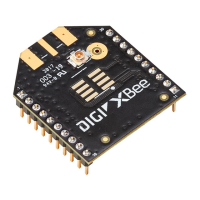Design recommendations Cellular component firmware updates
Digi XBee® 3 Cellular LTE Cat 1 AT&T Smart Modem User Guide
123
Cellular component firmware updates
Even if you do not plan to use the USB interface (Pin 7 and 8), we strongly recommend you provide a
way to access the USB pins (Pin 7 and 8) to support direct firmware updates of the Cellular modem.
You should keep Pins 7 and 8 routing as a 90 ohm diff pair for USB communications.
CAUTION! If you do not provide access to these USB pins, you may be unable to perform
cellular component firmware updates.
One way to provide access to the USB interface is to connect the USB pins to a header or USB
connector on the host design; see Run the MicroPython GPSdemo for more information. At a
minimum you should connect pins 7 and 8 to test points so they are easy to wire to a connector if
necessary.
If you are using the USB pins for other purposes you must provide a way to disconnect those
interfaces during USB operation, such as using zero ohm resistors.
Power supply considerations
When considering a power supply, use the following design practices.
1. Power supply ripple should be less than 75 mV peak to peak.
2. The power supply should be capable of providing a minimum of 1.5 A at 3.3 V (5 W). Keep in
mind that operating at a lower voltage requires higher current capability from the power
supply to achieve the 5 W requirement.
3. Place sufficient bulk capacitance on the XBee VCC pin to maintain voltage above the minimum
specification during inrush current. Inrush current is about 2 A during initial power up of cellular
communications and wakeup from sleep mode.
4. Place smaller high frequency ceramic capacitors very close to the XBee Smart Modem VCC pin
to decrease high frequency noise.
5. Use a wide power supply trace or power plane to ensure it can handle the peak current
requirements with minimal voltage drop. We recommend that the power supply and trace be
designed such that the voltage at the XBee VCC pin does not vary by more than 0.1 V between
light load (~0.5 W) and heavy load (~3 W).
Recommended application circuit
In high EMI noise environments, we recommend adding a 10 nF ceramic capacitor very close to pin 5.

